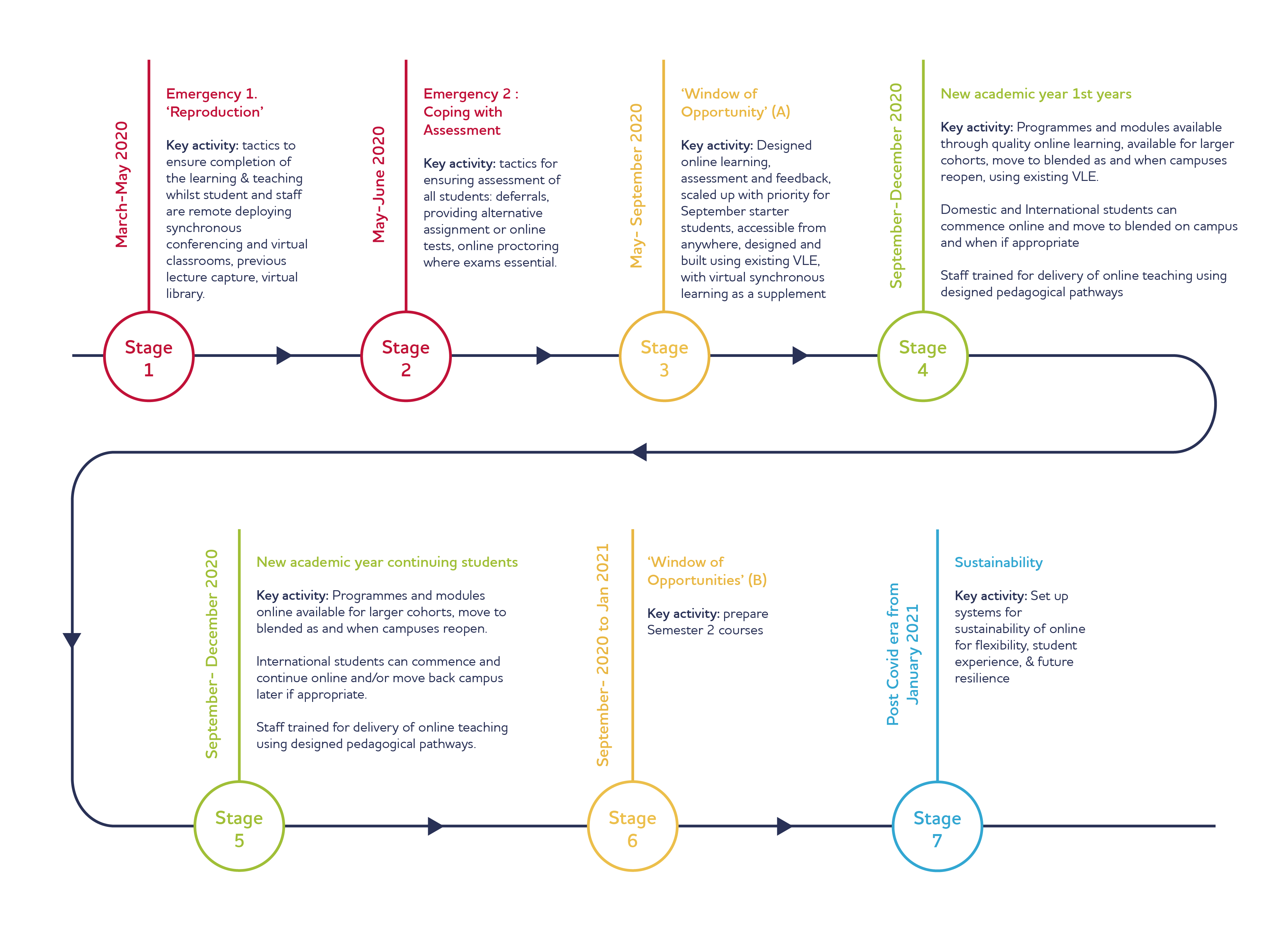Global events directly impact societal and organisational norms and may provide “pivot points” for widespread transformations.
Our initial reactions to an uncompromising and largely unevaluated threat are to react in whatever ways we can. Only over a little time, the complex interactions and consequences become clearer.
In organisations, giant changes, especially if enforced and unexpected, create a sense of lack of control over critical aspects of the external environment. And then, uncomfortable questions may be asked about foresight and preparedness for future hazards.
The feelings of challenge and shared adversity can however be deployed to drive helpful changes, if appropriately planned. Organisations that actively seek to “future-proof” – to harness and shape constructive developments – are more likely to use their scarce resources and energy in an optimal fashion, against their longer-term mission and goals.
The online learning challenge
The Covid-19 pandemic has required a rapid response within the campus-focused, embedded and historic culture of the thousand-year-old higher education system.
For students, the need for the shift to non-attendance is understood, if rather annoying. The virtual classrooms with their lags and latency have caused some concerns. Different approaches to assessment create unease.
Technology platform providers have seized the opportunity to make increased virtual space and affordances available. Meanwhile, academic staff have stepped up to their computers on a massive and impressive scale. Super rapid training and development has been offered and taken up. Many are attempting to emulate and apply what they know of university campus learning to the digital world. So far, in a situation of extreme widespread uncertainty, it has been best to do “what’s possible” rather than “what’s desirable”. It has already been labelled The Big Experiment.
But it is not quality online education. There has been 25 years of research and development of online higher education, and a much longer history of accessibility and scale, through “traditional” distance learning such as the Open University.
Cost effectiveness and equity have been at the forefront of all education of this kind. From the beginning of the OU and all its followers, and some notable successes in large scale online from campus universities too, the practice has been to design materials and pedagogical pathways once , and then deliver the learning many times. Co-design teams do the first part: including the academics, learning designers, developers, librarians and ideally alumni and employers. For the delivery, teaching online requires quite different skills from lecturing.
There are two key threshold concepts to grasp for entirely digital learning. First, to generate flexibility, pace, motivation and completion of activities, the most successful online experiences are mainly asynchronous. Pedagogical pathways need to be clearly scaffolded, designed and built with the end in mind, i.e. learning outcomes and application. Second, the focus shifts from what the academic does (contact hours) to total student study hours, by working through clearly laid out expectations and activities.
The university’s “spirit” and the “presence” of the academics (and their research) can continue to be offered throughout the learning experience. These approaches lead to student-centredness, a continued focus on quality experience for all, and in short, scalability, retention, and achievement.
Strategy by stages
University strategies are typically exceptionally long term and generated over periods of time —analysing trends, making forecasts, and committing to only the best course of action and use of resources. They are not conceived for the sudden, unexpected, and rapid change the pandemic has thrust upon us.
Here is my suggestion for one plan to achieve a shift from contingency to sustainability, without needing to alter intakes or semester start dates. The process illustrates how a university might move from the current situation in which established face-to-face practice is being replicated through available technology, towards sustainable, high-quality online models. And it helps to see it as a planning process with stages, so that resources are deployed at the right time and in the optimal way.
The windows of opportunity are open at this moment. Acting now will enable a university to fully appreciate how it can build capability and capacity to enable quality online and technology engaged learning. This may be to extend its existing internal provision. Or it could identify components of its complex educational processes that it can undertake in-house and/or identify aspects it needs immediate help with – perhaps tutoring, online exams, or student support. Or take this moment to seek external help to build a complete digital campus. Decisions can be taken on finding or diverting resources that will result in long term benefits.
Trying out new ways of learning and teaching enable staff and students to prototype for themselves, and engage in rapid feedback, evaluation, and improvements. Six months from now, the institution would have dramatically increased its knowledge and understanding of the viability of online education across different disciplines and be able to actively and widely, recruit and teach international students.
The subsequent shifts in practice will certainly offer great advantages for building resilience against any future big challenges to student recruitment and educational models. And handle the huge uncertainty over the timeline over the next year or more when students could and are willing to, travel and live on campus.
Universities that already have significant online programmes can repurpose these for campus-based students. Universities with little online provision for their main courses can prioritise for those programmes expecting large numbers and/or international students, deploying outside assistance for resourcing, speed, and quality. It can be done.
Click here to open a larger version
The outcome of the pivot plan would allow students to study on campus if travel is possible or online from wherever they are, and for as long as needed. It also offers a fundamental rethink about ambitions to offer online courses to international students. The plan would enable managing for the short-term but also signpost a fundamental shift in how learning is delivered hence providing a framework of sustainability, risk reduction and resilience to future shocks. Systems to collect results for evaluation can be built into every stage of online learning.
That is how we can create the future in a situation of uncertainty, using this driver to pivot faster and more effectively than ever before.
This article is published in association with OES.















Agreed that Covid 19 could be pivotal for the HE sector – not only as a fulcrum for change but critically in how that change is approached, managed and executed. A once in a lifetime storm has engulfed the sector, the Introduction of fees, removal of caps and other structural market changes necessitated responses but not of the scale that we now face. Although HE has never experienced anything of this magnitude, it is important to note that other organisations in other sectors have faced analgous situations and these offer useful indicators for a path ahead – FMCG, Retail, Financial… Read more »
Thank you for sharing such valuable information. It will help a lot of people. Keep it up…
oppnmedia.com
[…] Covid-19 context and so-called ‘pivot to online learning’ (WONKHE, 2020) has brought with it many challenges for higher education institutions, not least in terms of how we […]
[…] many assert was already losing its relevance’ and makes the positive case for change. One online provider argues that the pandemic could be a ‘driver’ to ‘pivot faster and more effectively than ever […]
[…] With these issues in mind, UCISA’s Digital Education Group conducted a series of panel interviews with institutional heads of e-learning over the summer 2021 to discuss how learning technology usage has changed over the emergency remote teaching (ERT) phase. The panel sessions were designed as a follow-up to the 2020 Technology Enhanced Learning Survey (full report here), which captured the learning technology landscape immediately preceding the so-called ‘pivot to online learning’ (WONKHE, 2020). […]